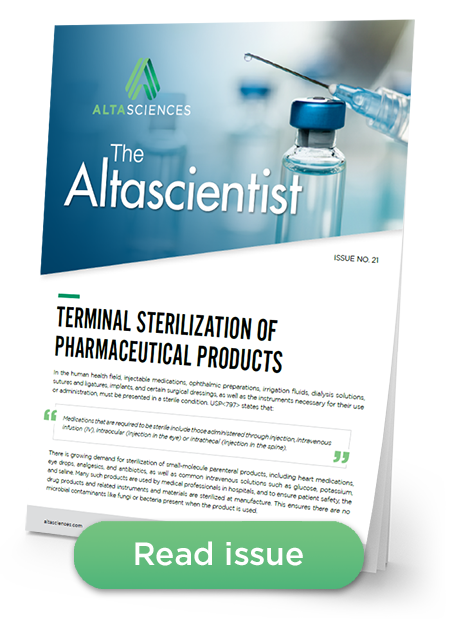ISSUE NO. 21 — Terminal Sterilization of Pharmaceutical Products

In the human health field, injectable medications, ophthalmic preparations, irrigation fluids, dialysis solutions, sutures and ligatures, implants, and certain surgical dressings, as well as the instruments necessary for their use or administration, must be presented in a sterile condition. USP <797> states: “Medications that are required to be sterile include those administered through injection, intravenous infusion (IV), intraocular (injection in the eye) or intrathecal (injection in the spine).”
There is a growing demand for sterilization of small-molecule parenteral products, including heart medications, eye drops, analgesics, and antibiotics, as well as common intravenous solutions such as glucose, potassium, and saline. Many such products are used by medical professionals in hospitals, and to ensure patient safety, the drug products and related instruments and materials are sterilized at manufacture. This ensures there are no microbial contaminants like fungi or bacteria present when the product is used.
In Issue 21 of The Altascientist, we review:
- the benefits of terminal sterilization over aseptic sterilization
- selecting the best terminal sterilization method for your pharmaceutical product
process validation
Terminal Versus Aseptic Sterilization for Pharmaceutical Products
Generally, regulatory agencies such as the FDA, EMA, among others, prefer terminal sterilization over aseptic, as it provides a high level of sterility assurance.
With terminal sterilization, most drug products are produced by mixing the ingredients to form the bulk drug product solution. The bulk product is filled into a tightly sealed container and the entire container is sterilized.
Terminal sterilization also offers time savings and cost advantages to pharmaceutical companies. Since terminal sterilization takes place after the formulation and filling steps, these initial manufacturing processes can occur in a less rigidly structured environment, which lowers the complexity, increases the speed, and therefore positively impacts the cost of manufacturing.
When terminal sterilization is not an option, aseptic processing is used. Each component (drug, container, closure, etc.) is individually sterilized first, then carefully assembled in a dedicated clean room with a highly controlled environment to make the finished drug product in a manner that prevents contamination. Containers, closures, and filling materials go through their own validated sterilization cycles.
Aseptic processing cannot provide the same quantitative level of sterility assurance as terminal sterilization, but it features several layers of control to minimize the risk of contamination.
Why Terminal Sterilization is the Ideal Choice for Pharmaceutical Products
Terminal sterilization is the preferred method for drug products because sterilization takes place after the product has been filled into the primary packaging, thus severely limiting further opportunities for contamination due to human intervention. The process is reliable, repeatable, and delivers an excellent quality product.
Terminal sterilization is also less complex, less costly, and more easily reproducible than aseptic processing. When conducted by well-trained, knowledgeable experts, sterilization conditions can be adapted to ensure they are appropriate to the drug product in question, and deliver the robust, thorough sterility results expected from this type of process.
In Altasciences’ Grade C suites, we develop injectable drug products and topical ophthalmic preparations that can be terminally sterilized after manufacture. All such drug processing is conducted in our Grade C, cGMP facility, which has been inspected by both the FDA and the European Union Quality Personnel.
Our team will guide you in the selection, method development and validation, and final delivery of fully sterilized product. We have decades of experience as a CDMO, and will ensure the efficient, effective implementation of the most appropriate sterilization method for your drug products.
Explore all issues of The Altascientist in our Resource Center. And don’t forget to subscribe to “The Altascientist: Audiobooks” on Spotify, Apple Podcasts, or wherever you get your audio content.